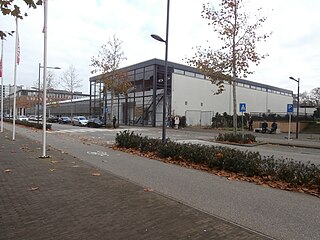
Home economics, or family and consumer sciences, is a subject concerning human development, personal and family finance, housing and interior design, food science and preparation, nutrition and wellness, textiles and apparel, and consumer issues.

Haarlem is a city and municipality in the Netherlands. It is the capital of the province of North Holland. Haarlem is situated at the northern edge of the Randstad, one of the most populated metropolitan areas in Europe; it is also part of the Amsterdam metropolitan area. Haarlem had a population of 161,265 in 2019.

Education in the Netherlands is characterized by division: education is oriented toward the needs and background of the pupil. Education is divided over schools for different age groups, some of which are divided in streams for different educational levels. Schools are furthermore divided in public, special (religious), and general-special (neutral) schools, although there are also a few private schools. The Dutch grading scale runs from 1 to 10 (outstanding).

A vocational school is a type of educational institution, which, depending on the country, may refer to either secondary or post-secondary education designed to provide vocational education or technical skills required to complete the tasks of a particular and specific job. In the case of secondary education, these schools differ from academic high schools which usually prepare students who aim to pursue tertiary education, rather than enter directly into the workforce. With regard to post-secondary education, vocational schools are traditionally distinguished from four-year colleges by their focus on job-specific training to students who are typically bound for one of the skilled trades, rather than providing academic training for students pursuing careers in a professional discipline. While many schools have largely adhered to this convention, the purely vocational focus of other trade schools began to shift in the 1990s "toward a broader preparation that develops the academic" as well as technical skills of their students.

Education in Indonesia falls under the responsibility of the Ministry of Education, Culture, Research, and Technology and the Ministry of Religious Affairs. In Indonesia, all citizens must undertake twelve years of compulsory education which consists of six years at elementary level and three each at middle and high school levels. Islamic, Christian, and Catholic Schools are under the responsibility of the Ministry of Religious Affairs.

The Frans Hals Museum is a museum located in Haarlem, the Netherlands.

Haarlem railway station is located in Haarlem in North Holland, Netherlands. The station opened at September 20, 1839, on the Amsterdam–Rotterdam railway, the first railway line in the Netherlands. The station building itself is a rijksmonument.

The Ambachtsschool in Heerlen is a brick building with distinctive layers of marl. It is notable as one of the earliest vocational schools in the Netherlands. The building is located on the Burgemeester de Hesselleplein, in Heerlen.

Daniël "Daan" de Clercq was a Dutch socialist and activist.

Academie Minerva is a Dutch art academy.
Maria Parloa was an American author of books on cooking and housekeeping, the founder of two cooking schools, a lecturer on food topics, and an early figure in the "domestic science" movement. A culinary pioneer, she was arguably America's first celebrity cook, considered "one of the innovative superstars of her field".

The Middelbare Technische School is a former MTS middelbare school on the Verspronckweg, Haarlem, The Netherlands. It is one of the oldest public vocational schools in Haarlem, built as a boys school in 1919, which grew out of the first Ambachtsschool that was located on the Kamperstraat. It currently houses one of the locations of the Sterren College.

The Haarlemse Huishoud en Industrieschool is a former huishoud school on the Voorhelmstraat, Haarlem, Netherlands. It is the oldest public day school for girls in Haarlem, built in 1901, which was renovated in 1935. It is currently rented as separate units for small businesses.

Mons Aurea, or ROC Nova College is a middelbare school and former "huishoud school" on the Garenkokerskade, Haarlem, The Netherlands. It also offers various facilities for adult education.

Johannes Jacobus, or J.J. Beijnes was a Dutch businessman and entrepreneur who, along with his brother Antonie Johannes (A.J.) Beijnes, was credited with growing the Haarlem factory Beijnes into an international manufacturer of train and tram wagons.

Beijnes is a defunct Haarlem manufacturer of carriages, buses, trains, and trams. It was closely associated with the Hollandsche IJzeren Spoorweg-Maatschappij (HIJSM)

Shizuoka Prefectural Hamana Senior High School is a public co-educational senior high school in Hamakita-ku, Hamamatsu, Japan.

Haerlempjes refer to a specific genre of landscape painting that includes a view of Haarlem. It is used most often to refer to Jacob van Ruisdael's panoramic views of the city, but the term is derived from mentions in Haarlem archives as a type of painting included in household inventories. The diminutive suffix "pje" would denote a small, cabinet-sized painting, but even the largest landscapes may be referred to as Haerlempjes today.

Amy Geertruida de Leeuw, known by the pen name Geertruida Carelsen, was a Dutch author and journalist.

The Royal Academy of Arts and Design was an academy for art education in 's-Hertogenbosch. In 2004 it merged with the Art Academy St. Joost from Breda to become the Academy of Art and Design St. Joost located in both Breda and 's-Hertogenbosch.




















